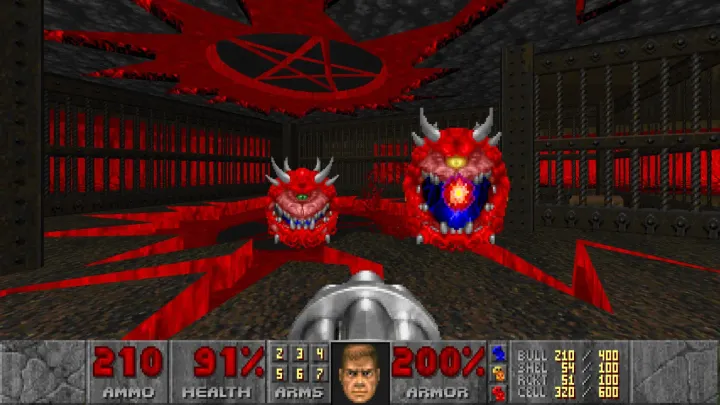
If you thought that the original Doom couldn’t possibly be released again, you’re dead wrong. Nightdive Studios, iD Software, and MachineGames released Doom + Doom II at QuakeCon 2024 earlier this month, giving the foundational classic its most souped-up version yet
Although Doom and Doom II: Hell on Earth get rereleased every few years — and have a reputation for running on anything — Doom + Doom II is their best rerelease yet. It includes all official Doom episodes, including a new one called Legacy of Rust. It has full online support for co-op and multiplayer, a vault featuring never-before-seen assets, and it’s very mod-friendly, as even players on current-gen consoles have access to mods right from the main menu.
Doom + Doom II feels as enjoyable as any modern game launching this month. That strength has given it a community that feels stronger than ever, with many former modders responsible for bringing this new collection to life. Speaking to developers from Nightdive, I came to understand that the original Doom games are an unstoppable force that can never die because the very developers keeping the classics alive are now the same people who were initially inspired by it.
The ‘gravitational pull’ of Doom
Nightdive is one of the premier game studios remastering and remaking older, beloved games. Founded in 2014 after co-founder Stephen Kick acquired the rights to System Shock 2, Nightdive made a name for itself over the last decade with remasters of many classic PC games, namely shooters like System Shock, Turok, and Star Wars: Dark Forces. But the developers from Nighdive I spoke to all had some connection to Doom.

Co-founder Daniel Grayson tells Digital Trends that he remembers discovering the franchise through the scary Doom 3 and going back and checking out the source versions of the prior games. Larry Kuperman, director of business development, recalled playing Doom when it came out via a Shareware disc, which essentially gave people a bit of the game for free in the hopes that they’d pay for the full thing. Kuperman even went through an effort to create cables that would enable him to play Doom multiplayer with his nephew.
Other developers at Nightdive were plucked directly from the Doom modding community. Two prime examples Kuperman cited were Samuel Villarreal, who had worked on a PC port of Doom 64 before joining Nightdive, and Edward Richardson, who is known for his work on ZDoom’s networking code and now helps restore multiplayer in Nightdive’s remasters, including Doom + Doom II. Another Doom modder who ended up joining Nightdive and helped spearhead the development of Legacy of Rust was Xaser Acheron.
What tends to keep people into the game is once you realize how wide and how deep the well goes.
Acheron’s body of mod work spanned over two decades before official content on Doom + Doom II was released. “There’s a little bit of a joke about how Nighdive has become the Doom community vortex, but that just speaks to how plugged in Nightdive is with the modding community, with the experts that enjoy and love these games,” Acheron tells Digital Trends.
Concurrently with Nightdive’s rise, the Doom modding scene has thrived. Even developers of the original game, like John Romero, have created Doom mods of their own. At QuakeCon this year, Id Software announced mod support for Doom Eternal, a rarity for a modern game that makes sense when considering the classics’ passionate modding community.

“People don’t see it as an old, ancient game as much as they see it as a cool, retro vintage thing. On top of that, once you start going past the surface, there’s an insane amount of community-created content like mods,” Archeron tells Digital Trends. “Hundreds of thousands of levels have been made for this game. What tends to keep people into the game is once you realize how wide and how deep the well goes. It has got a gravitational pull. As a kid, I remember being floored when I found out you can go to the internet and download more Doom.”
The path to Doom + Doom II
Doom + Doom II isn’t the first time Nightdive has worked with Id Software and Bethesda. Ahead of the launch of Doom Eternal, Kuperman tells Digital Trends that Nightdive tried reaching out to Bethesda about working on a Doom 64 remaster inspired by Villarreal’s fan-made PC conversion. At the same time, a Bethesda developer named Rob Echter asked Nightdive if they were interested in collaborating on a Doom 64 port, unaware of Nightdive’s pitch.
When that happened, the two companies agreed to start working together. Doom 64 was eventually rereleased as a preorder incentive for Doom Eternal across all platforms before getting a standalone launch of its own. From there, Nightdive worked on remasters of Quake and Quake 2, and that journey has now culminated with Doom + Doom II. Kuperman had nothing but nice things to say about working with Id Software and Bethesda Softworks.
“In my experience, there is no company out there that pays more attention and has more concern for its wider community, specifically for the modding community, as Bethesda,” Kuperman says. “That is something that is top of mind in all these projects, which is something that makes the development work a little more challenging. But we support that and are more than happy to do whatever it takes to best support modders since that is the community we’ve largely drawn the Nightdive team from.”

Kuperman says Bethesda and id largely spearheaded the vision for Doom + Doom II, including the collection’s friendly integration of mods and the inclusion of an Id Vault featuring cut content from the original games. Still, Nightdive impressively created one of the best-looking and best-playing rereleases of Doom and its sequel utilizing its Kex Engine, the framework it uses to remaster all of these shooter classics.
Some aspects of Doom’s gameplay are comparatively dated by modern standards, like the fact that players can’t aim up or down. Despite that, Id Sofware’s original level, weapon, and enemy designs still hold up and feel just as exhilarating to play in 2024 as they likely did in 1993. Nightdive did a fantastic job with its refurbishment, but you need a truly remarkable game to stand the test of time and have a passionate community like Doom has. Doom + Doom II reminded me of that.
Modders make Doom
One of the tallest tasks of Doom + Doom II was creating a new, official episode for the package that could be presented alongside the originals. In creating Legacy of Rust, Acheron says he looked back to his past in modding to inform its design. The overall concept of Legacy of Rust is “Earth invading Hell” rather than “Hell invading Earth,” Acheron explains. That gives the episode a distinct look and makes it feel like the kind of oddball concept you’d get from a mod finding clever ways to use game assets.
This entire project was an amazing opportunity to put together all the things I love about Doom modding.
Nightdive also had the benefit of accessing and reusing previously cut Doom content and having modding experience. Legacy of Rust’s developers went further than your standard Doom mod or fan-made episode. That was only possible because Acheron and many of the developers he collaborated with to create these levels have that modding background and love for Doom. That’s something Acheron is very appreciative of.
“This entire project was an amazing opportunity to put together all the things I love about Doom modding and get some amazing people who know what they’re doing to chip in,” Acheron says. “I’m just flattered that they stepped in and kicked some ass.”

I’m grateful that Nightdive, Id Software, and Bethesda were able to come together and make Doom + Doom II happen. The remaster lacks any of the weird caveats of previous rereleases. Each part of the package, down to the modding support, clearly shows that developers made it with experience and knowledge of Doom. Kuperman hopes that their work here can go on to inspire the next generation of Doom fans.
“There are people out there who, until this game came out, did not know that there was such a thing as modding and would not have done it. Now their eyes have been opened, and that’s where the next generation of modders come from,” Kuperman says.
If there’s a next generation of modders thanks to studios like Nightdive, Id, and Bethesda, then that’s yet another way to ensure that the legacy of the original Doom games will never die, even as the series goes on and explores its limits with modern games like Doom: The Dark Ages. And if we’re looking back years from now, Doom + Doom II should stand out as one of the best versions of these classic shooters that changed the video game industry forever.




